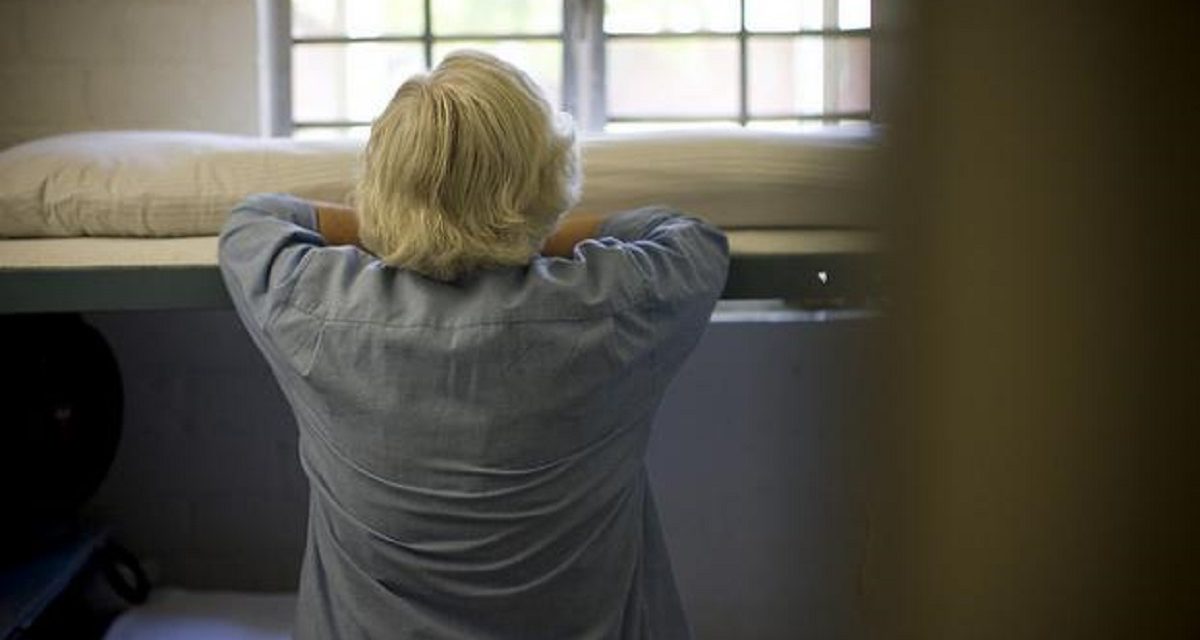Brenda Clubine spent 26 years in prison for killing her husband. After years of enduring beatings and ER visits, she said the abuse finally ended in a locked motel room. Clubine’s husband asked for her wedding rings. She said when she asked why, he said, “Because tomorrow they won’t be able to identify your body without them.”
Clubine hit him in the head with a wine bottle. He died from blunt force trauma. Clubine, who was released not long ago from a California prison, still visits the facility at least once a month. She attends a support group she started more than 20 years ago called Convicted Women Against Abuse.
Some of the inmates stand out, like the ones with gray hair and walkers. Glenda Virgil is 65, sits in a wheelchair and has spent almost 30 years in prison. She said her arrest photos show her husband’s kick prints all over her back.
Another inmate, Rosemary Dyer, is 60 years old and has been in prison since 1988 for killing her husband. Dyer said she receives letters from other domestic violence victims asking for advice. For six months, she communicated with a woman who was being abused by her baby’s father. The letters stopped coming. Dyer later found out that the man killed the woman and the child. “He killed them both,” she said. “The only thing I could think of was, ‘What more could I have said to express to her the importance to get away?’”
As many as four million women die each year at the hands of their partner or spouse. Victims who fight back, like Clubine, Dyer, Virgil and thousands more, often face long prison sentences. According to the latest estimates, at least 4,500 women are currently incarcerated for killing an abusive partner.
Systemically, crimes involving domestic abuse victims fighting back or even killing their abuser are not given special consideration in the court system.
Prime examples are three women in Missouri who have served decades in prison after defending themselves against spousal abuse. All three served sentences dating back to the 1970s and 1980s.
For 10 years, a group of attorneys called the Missouri Clemency Coalition Project (MCCP) argued for the women’s release. Their defense was that these women were driven to kill after suffering repeated abuse from their husbands.
MCCP also argued that at the time of the women’s arrests, few resources were available for battered women, domestic violence was poorly understood, and evidence of abuse was not routinely presented in trials.
In 2007, a law passed in Missouri that said offenders who had murdered their spouses could be eligible for parole if they served 15 years in prison, had no prior felony convictions, and had a history of “substantial physical abuse or sexual domestic violence” not presented at trial.
Still, the Missouri Board of Probation and Parole twice denied these women their freedom. After the second rejection in 2009, MCCP sued the parole board and got another court order forcing the board to reconsider the cases. Hearings were held in Jefferson City last year.
Two of the women, one 56 and the other 66, were granted parole last year. The third woman, 58, was freed from a Missouri prison this year.
“The journey to free the final three was long and hard,” said Patricia Harrison, J.D., assistant clinical professor of law at St. Louis University and a member of MCCP. “All of the women had exemplary institutional behavior, no prior record, excellent work history in and out of prison, and strong family support. Most significantly, all had suffered years of torture at the hands of their husbands–and they had not been allowed to present evidence of their abuse to the jury.”
Harrison said when she first became involved in 2007, she assumed that the parole hearings would be a formality. She said the abuse these women had suffered was horrific and was supported by letters and affidavits of witnesses to the injuries or incidents of abuse. “The reality was different from what I had imagined: two parole denials, two writ of mandamus (used in cases where there is a specific right but no legal remedy to enforce that right) victories, and finally success in the third try,” Harrison said.
Solidarity, a women’s rights group, contends that in the U.S., killing in self-defense is not a crime. However, for most women, neither the laws of self defense nor evidence of battering work in actual trials. As a result, Solidarity estimates that 75-80 percent of women who killed in self defense are convicted or convinced to plead guilty, and thus sentenced to long prison sentences.
“You’d be surprised how society views battered women and the judgment they have for them,” said a woman who goes by the name “Kelli,” who was sent to prison at 19 and served 15 years for killing her husband. She said the first thing the prosecutor said to her was, “Why didn’t you call the hotline?” Kelli said she didn’t know about hotlines, and she tried to get help before. Some of her own family members said she caused her situation by staying with her abuser. Battered Woman Syndrome (BWS) was used as defense in Kelli’s trial and failed. BWS, also referred to as the battered woman’s defense, is characterized by depression and an inability to take independent action to escape the abuse. The condition explains why abused people may not accept assistance or leave an abusive situation.
“I don’t think I did anything wrong by protecting my children and our lives. I think people want to see a sense of remorse from people who kill their abusers. But how can you have a sense of remorse for a person who is killing you daily?” Kelli’s boys were 16 and 17 by the time she was paroled.








